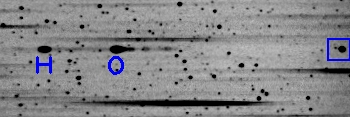
A note on focusing when using a transmission grating....



Spectral images (cropped from full-frame ST-6 images) of planetary nebulae NGC 3918, 6572 and 5307 respectively, from top to bottom. The zero-order image is in the box to the right; the spectrum extends to the left, and the locations of the OIII and Ha emission "lines" are marked. Dispersion is 21.9 Å/pixel.
When these original images are viewed at appropriate brightness and contrast settings, it is noted that the monochromatic spectral images (i.e. the monochromatic images of the source- in the spectrum- due to the emission lines of the nebulae) are in fact not in focus. This may be seen by comparing the size of the zero-order image with that of any spectral-line image, and that the latter are the classic "doughnuts" associated with an out-of-focus image in a Schmidt-Cassegrain telescope.
This problem is more apparent when the grating is placed further from the CCD, i.e. when the dispersion is increased. It is not particularly evident at the 58.1 Å/pixel dispersion used for the quasar spectroscopy images, but is very much evident at the higher dispersion of 21.9 Å/pixel. Thus, for the purpose of improving the quality of the spectrum, the telescope should be focused using the monochromatic spectral images, and not the zero-order image. Presumably, this is due to the grating's characteristic of having a curved surface of best focus (compared with the telescope's relatively (but still curved...) flat focal surface).
The image below shows traces through the spectra of NGC 3918 and 6572. The zero-order images have been aligned, and the intensities offset for clarity. The intensity scale is arbitrary, and the x-axis is in pixels. Note that the Ha image (near pixel 315), especially, is somewhat extended when compared with the zero-order image, and in fact shows a double-peaked structure, as expected. This is not due to real detail in the spectrum (e.g. multiple emission lines or red- or blue-shifted emission), but simply to the unfocused spectral images as already noted.

Of course, this means that all these images will need to be taken again....
....and here is the result of using the spectrum for focusing.
![]()
![]()
![]()
Cropped images of NGC 3918 (top), 6572 (middle) and 5307 (bottom). The increased resolution within the spectrum is very apparent in the image of NGC 3918, where the lines short of the OIII line (i.e. to its right) are now visible as separate features, and not just blobs. For NGC 6572, although the focus on the spectrum is not perfect, a number of lines apart form the main Ha and OIII are visible (some are marked). In the image of NGC 5307, the improvement is evident, but not as dramatic as for 3918. This last PN evidently has very little emission aside from Ha and OIII.